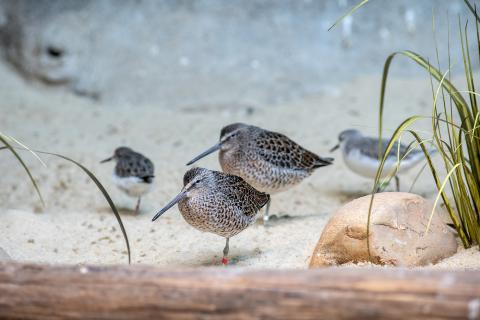Physical Description
This snake's large, smooth scales are uniformly glossy black, with red or cream colored accents possible around the chin, throat and sometimes the cheeks. Eastern indigo snakes are nonvenomous.
Size
Eastern indigo snakes are the longest snakes found in the United States, reaching lengths of 5 to 7 feet (1.5 to 2 meters), with the record length exceeding 8.5 feet (2.5 meters).
Native Habitat
Native to the southeastern United States, eastern indigo snakes occur primarily throughout the peninsula of Florida into parts of southern Georgia, Alabama and a small portion of southeast Mississippi. This snake's historical range extends to South Carolina, but the species is considered very rare or extirpated there and throughout most of Alabama and Mississippi.
Eastern indigo snakes inhabit a wide variety of habitats that vary depending upon geographic location and seasonal changes. Their preferred environment includes pine and scrubby flatwoods, pine rocklands, sandhills, dry prairie, edges of freshwater marshes, agricultural fields and human-altered habitats. They sometimes seek shelter underground due to temperature changes. Northern-dwelling eastern indigo snakes most often utilize gopher tortoise burrows. Hollowed logs or rodent burrows also provide sufficient shelter for snakes in wetter habitats.
Lifespan
Information on the life span of eastern indigo snakes in the wild is not available. The longest this species has survived in human care is 25 years and 11 months.
Food/Eating Habits
Eastern indigo snakes are active, terrestrial predators known to expose and chase down prey. They eat a wide variety of animals, including small mammals, birds, frogs, turtles, turtle eggs and other snakes — even venomous species like cotton mouths and rattlesnakes. They occasionally climb shrubs or trees in search of food.
Juveniles primarily prey on invertebrates. Prey, such as rats, that are strong enough to put up a fight are not killed by constriction. Instead, they are pressed against stationary structures like burrow or tunnel walls. Holding this type of prey in place requires a strong bite.
At the Smithsonian's National Zoo, these snakes eat birds, fish and rodents.
Sleep Habits
Eastern indigo snakes are diurnal.
Reproduction and Development
Most of what is known about the breeding habits of eastern indigo snakes reflects information gathered from populations in northern Florida. Breeding season runs between November and April, with females laying four to 12 eggs during May or June. Young hatch after three months of incubation, normally between August and September. In south-central Florida, breeding occurs from June to January, with egg laying between April and July and hatching from mid-summer to early fall. Hatchlings typically measure 17 to 24 inches (43 to 61 centimeters) in length.
Females have the ability to store sperm and delay fertilization of eggs if necessary. A single record exists of an individual in human care laying five eggs after being isolated for more than four years. Additionally, there have been reports of parthenogenetic reproduction, a form of asexual reproduction in which embryos develop without fertilization, which may draw the occurrence of sperm storage for more than four years into question.
Conservation Efforts
The U.S. Fish and Wildlife Service lists the eastern indigo snake as threatened due to a dramatic decline in population. Habitat loss and deforestation are this species' primary threats. Large areas of natural, unaltered habitat are rapidly disappearing.
Additional threats include over-collection for the pet trade, habitat fragmentation and mortalities as an indirect consequence of the gassing of gopher tortoise burrows by rattlesnake collectors. In the event of excessive human development, fragmented snake populations may be able to sustain in protected areas of wild land, but it is unlikely that these populations would remain viable.
Conservation efforts have been enacted at the federal and state levels. Eastern indigo snakes are protected at the state level in Alabama and have full protection as a threatened species in Florida and Georgia. In South Carolina and Mississippi, they are protected as an endangered species. Additionally, eastern indigo snakes in institutions accredited by the Association of Zoos and Aquariums are managed under a Species Survival Plan.
One potential measure of the health and recovery of this species is the presence of gopher tortoises. Eastern indigo snakes are one of more than 200 species that inhabit tortoise burrows. If conservationists work to recover the population of gopher tortoises, which are currently considered vulnerable by the International Union for Conservation of Nature, there would likely be a similarly healthy population of eastern indigo snakes in that area.
Conservation methods currently in place to protect eastern indigo snakes include prescribed burning to maintain ideal habitat, the continuation of a breeding colony in human care, gaining cooperation from local landowners and increased public education and outreach.
Research at the Smithsonian's National Zoo
In partnership with the Orianne Society, Zoo staff participate in eastern indigo snake field surveys and conservation work in Georgia. They hope to one day assist with eastern indigo snake reintroductions.
Help this Species
- Choose your pets wisely, and do your research before bringing an animal home. Exotic animals don’t always make great pets. Many require special care and live for a long time. Tropical reptiles and small mammals are often traded internationally and may be victims of the illegal pet trade. Never release animals that have been kept as pets into the wild.
- If you see a snake in the wild, leave it alone and encourage others to do the same. Don’t assume it is a venomous species, and don’t attack it if it doesn’t pose a threat to your safety. Tell your friends and family about the eco-services that snakes provide, such as keeping rodent populations in check.
Animal News

Leaf-tailed Gecko Treated for Skin Cancer With Chemotherapy



